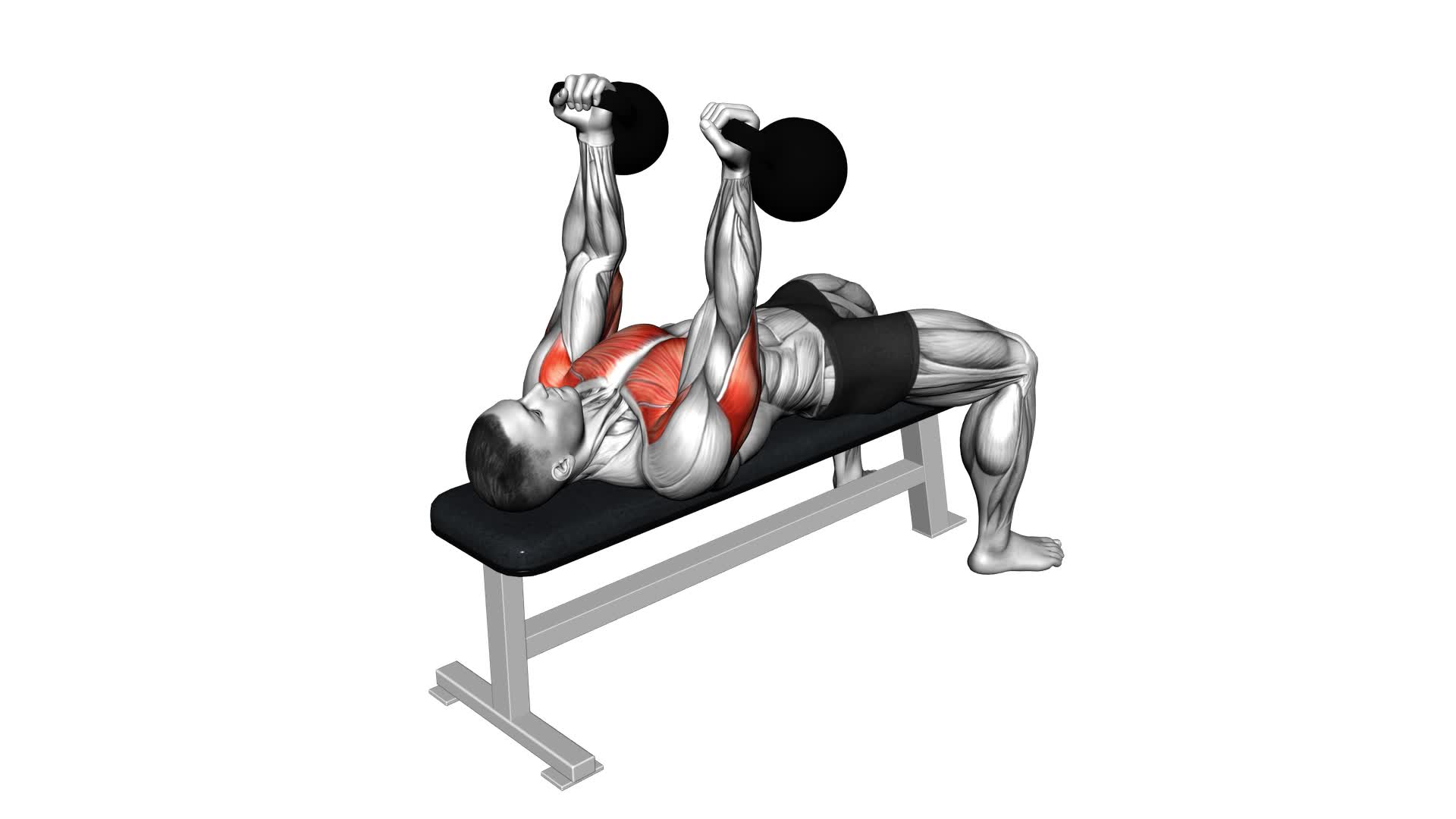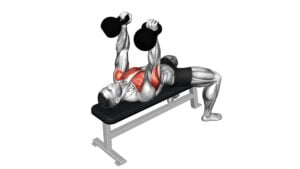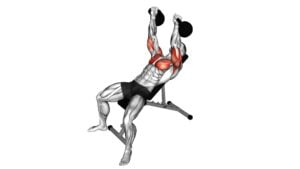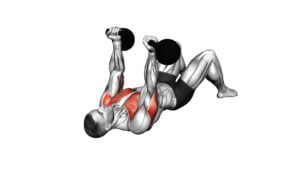Kettlebell Reverse Bench Press – Video Exercise Guide & Tips

Looking to level up your upper body workout? The Kettlebell Reverse Bench Press is here to challenge you!
Watch This Exercise Video
In this video exercise guide, we'll show you the proper form and technique to maximize your results.
With variations to target different muscle groups, you can tailor this exercise to your fitness level.
Plus, we'll point out common mistakes to avoid and provide tips for incorporating the Kettlebell Reverse Bench Press into your routine.
Get ready to take your strength training to the next level!
Key Takeaways
- The Kettlebell Reverse Bench Press targets the chest, shoulders, and triceps, engaging multiple muscle groups simultaneously.
- Proper form and technique are important, including lying flat on a bench with feet firmly planted, maintaining a stable and controlled movement, and avoiding arching the back or flaring the elbows out.
- Recommended sets and reps for the exercise are 3-4 sets of 8-12 reps per workout session, gradually increasing the weight as strength improves, and resting for 1-2 minutes between sets for muscle recovery.
- To maximize effectiveness, it is important to engage core muscles, focus on the mind-muscle connection, avoid excessive momentum, and incorporate the Kettlebell Reverse Bench Press into a well-rounded upper body workout routine.
Benefits of Kettlebell Reverse Bench Press
You can experience various benefits from performing the Kettlebell Reverse Bench Press. This exercise primarily targets the muscles of your chest, shoulders, and triceps. As you lower the kettlebells towards your chest, your pectoralis major and minor muscles are engaged, along with your anterior deltoids.
The triceps brachii muscles, located on the back of your upper arm, are also activated as you extend your arms and push the kettlebells away from your body.
To increase resistance in the Kettlebell Reverse Bench Press, you have a few options. First, you can choose a heavier kettlebell. The additional weight will challenge your muscles and help you build strength. Another option is to increase the number of repetitions you perform. By doing more reps, you'll fatigue your muscles and create a greater training stimulus. Finally, you can also increase the number of sets you complete. Adding an extra set will provide more volume to your workout, leading to increased muscle growth and strength gains over time.
Incorporating the Kettlebell Reverse Bench Press into your workout routine can help you develop a strong and well-defined upper body. By targeting the chest, shoulders, and triceps, this exercise can contribute to improved muscle strength and size in these areas.
Proper Form and Technique
To perform the Kettlebell Reverse Bench Press with proper form and technique, begin by lying on your back with the kettlebells held securely in your hands. Make sure your feet are flat on the ground and your knees are bent at a 90-degree angle. This position will provide you with a stable base and help you maintain proper form throughout the exercise.
Now, lower the kettlebells towards your chest while keeping your elbows tucked in close to your body. As you press the kettlebells back up, focus on engaging your chest, shoulders, and triceps. This exercise primarily targets your chest muscles, but it also engages your shoulders and triceps for added strength and stability.
To ensure proper form and technique, avoid common errors such as arching your back or flaring your elbows out to the sides. These mistakes can put unnecessary strain on your lower back and shoulders, increasing the risk of injury. Instead, keep your core engaged and maintain a controlled and steady movement throughout the exercise.
By performing the Kettlebell Reverse Bench Press correctly, you'll activate and strengthen your chest, shoulders, and triceps effectively. This exercise is an excellent way to challenge your upper body and build strength.
Now that you have mastered the proper form and technique, let's move on to the next section, which will explore some variations to further challenge your upper body.
Variations to Challenge Your Upper Body
Now let's explore some ways to further challenge your upper body with variations of the Kettlebell Reverse Bench Press.
If you're looking to take your workout to the next level, these modifications will do just that.
One modification you can try is the Single Arm Kettlebell Reverse Bench Press. Instead of using both arms, you'll use just one kettlebell, which will require more stability and strength from your core and upper body.
Another variation is the Kettlebell Reverse Bench Press with a Twist. To do this, simply twist your torso as you press the kettlebell up, engaging your obliques and adding an extra challenge to your upper body workout.
If you're really looking for an advanced kettlebell upper body exercise, try the Kettlebell Reverse Bench Press with a Leg Raise. As you press the kettlebell up, raise one leg off the ground and hold it there for a few seconds before lowering it back down. This variation not only challenges your upper body, but also targets your core and lower body stability.
Incorporating these kettlebell reverse bench press modifications into your workout routine will help you continue to challenge and strengthen your upper body.
Common Mistakes to Avoid
It is important to frequently check for common mistakes when performing the Kettlebell Reverse Bench Press. Proper technique is crucial to prevent injuries and maximize the effectiveness of this exercise.
One common mistake to avoid is using too heavy of a kettlebell. It's essential to choose a weight that allows you to maintain proper form throughout the exercise. Using a kettlebell that's too heavy can lead to muscle strain and compromise your technique.
Another common mistake is arching your back excessively. This can put unnecessary stress on your lower back and increase the risk of injury. To avoid this, engage your core muscles and keep your back flat against the bench throughout the movement.
Additionally, avoid letting your elbows flare out to the sides. This can place strain on your shoulders and decrease the activation of your chest muscles. Instead, keep your elbows tucked in close to your body as you press the kettlebells up.
Tips for Incorporating Kettlebell Reverse Bench Press Into Your Workout Routine
When incorporating the Kettlebell Reverse Bench Press into your workout routine, focus on maintaining proper form and utilizing compound movements. This exercise is a great way to incorporate kettlebell exercises into your routine while targeting your chest and triceps.
To start, lie flat on a bench with your feet planted firmly on the ground. Grab the kettlebells with an overhand grip, palms facing away from you. Extend your arms straight up, directly above your shoulders. This is your starting position.
As you lower the kettlebells down towards your chest, make sure to keep your elbows tucked in and maintain control throughout the movement. Once the kettlebells touch your chest, push them back up to the starting position, fully extending your arms.
To maximize the effectiveness of this exercise, focus on using your chest and triceps to drive the movement. Avoid using momentum or relying on other muscle groups to lift the kettlebells. Keep your core engaged and maintain a steady, controlled pace throughout the exercise.
Incorporating the Kettlebell Reverse Bench Press into your workout routine can help you build strength and definition in your chest and triceps. Aim for 3-4 sets of 8-12 reps, gradually increasing the weight as you become more comfortable with the exercise. Remember to always consult with a fitness professional before starting any new exercise routine.
Frequently Asked Questions
How Heavy Should the Kettlebell Be for the Reverse Bench Press Exercise?
To determine how heavy the kettlebell should be for the reverse bench press exercise, consider your fitness level and strength. Beginners should start with lighter weights, gradually increasing as they build muscle. It's important to choose a weight that challenges you without sacrificing form.
As for whether the reverse bench press is suitable for beginners, it can be a great exercise to target your chest and triceps. Just make sure to start with proper technique and gradually progress.
Is the Reverse Bench Press Suitable for Beginners?
The reverse bench press can be a suitable exercise for beginners. It helps to improve overall strength and targets the chest, shoulders, and triceps.
By using kettlebells, you can add an extra challenge and engage more muscles. Start with a lighter kettlebell and focus on maintaining proper form.
As you progress, gradually increase the weight to continue challenging your muscles. Always listen to your body and consult with a fitness professional if needed.
Can the Reverse Bench Press Help Improve Core Strength?
The reverse bench press is a great exercise for improving core strength. By engaging your core muscles to stabilize your body during the movement, you'll see improvements in balance and stability.
In addition to the traditional kettlebell reverse bench press, there are variations that can challenge advanced users even more. These variations include using a single-arm kettlebell or adding a twist at the top of the movement.
Incorporating these variations can further enhance your core strength and stability.
Should I Perform the Exercise With Both Arms Simultaneously or Alternate Between Them?
To get the most out of the exercise, it's recommended to alternate between both arms when performing the Kettlebell Reverse Bench Press. This helps to engage your core muscles and improve stability.
Compared to the regular bench press, the alternating arm movement adds an extra challenge, targeting different muscle groups and enhancing overall balance and coordination.
Can the Reverse Bench Press Help With Shoulder Stability and Mobility?
The reverse bench press can be a valuable exercise for shoulder stability and mobility. By performing this kettlebell exercise, you can effectively target and strengthen the muscles that support your shoulders.
This can be especially beneficial for shoulder rehabilitation, as it helps to improve joint stability and range of motion. The reverse bench press allows you to work on your shoulder mobility in a controlled and safe manner, making it a great addition to your workout routine.
Conclusion
Incorporating the Kettlebell Reverse Bench Press into your workout routine can provide numerous benefits for your upper body. By maintaining proper form and technique, you can effectively target your chest, shoulders, and triceps while also engaging your core muscles.
With variations available to challenge yourself, it's important to avoid common mistakes such as arching your back or using excessive weight. By following these tips, you can maximize the effectiveness of this exercise and achieve your fitness goals.

Author
Years ago, the spark of my life’s passion ignited in my mind the moment I stepped into the local gym for the first time. The inaugural bead of perspiration, the initial endeavor, the very first surge of endorphins, and a sense of pride that washed over me post-workout marked the beginning of my deep-seated interest in strength sports, fitness, and sports nutrition. This very curiosity blossomed rapidly into a profound fascination, propelling me to earn a Master’s degree in Physical Education from the Academy of Physical Education in Krakow, followed by a Sports Manager diploma from the Jagiellonian University. My journey of growth led me to gain more specialized qualifications, such as being a certified personal trainer with a focus on sports dietetics, a lifeguard, and an instructor for wellness and corrective gymnastics. Theoretical knowledge paired seamlessly with practical experience, reinforcing my belief that the transformation of individuals under my guidance was also a reflection of my personal growth. This belief holds true even today. Each day, I strive to push the boundaries and explore new realms. These realms gently elevate me to greater heights. The unique combination of passion for my field and the continuous quest for growth fuels my drive to break new ground.







